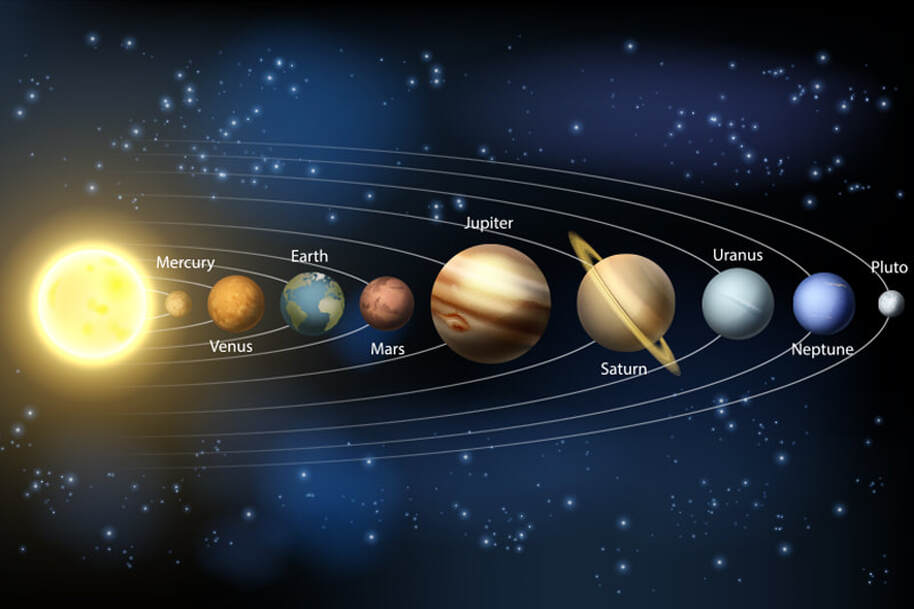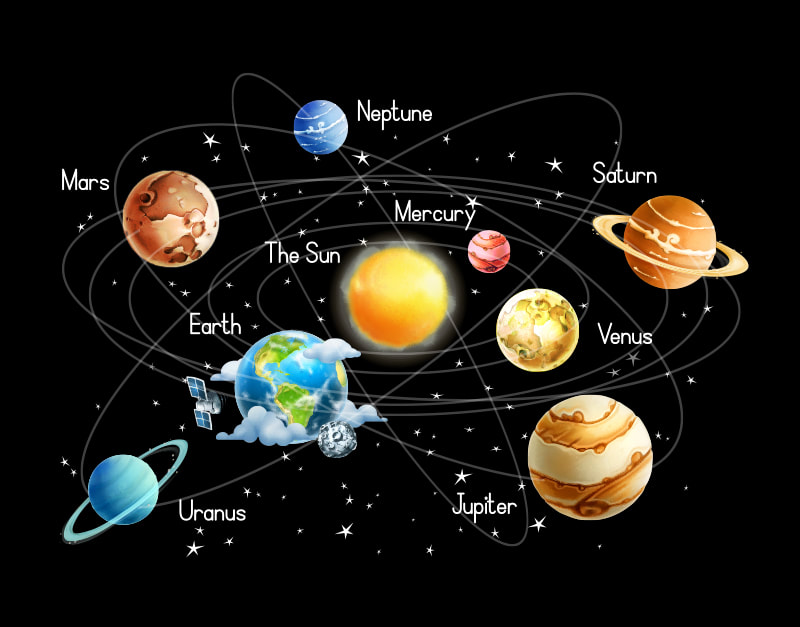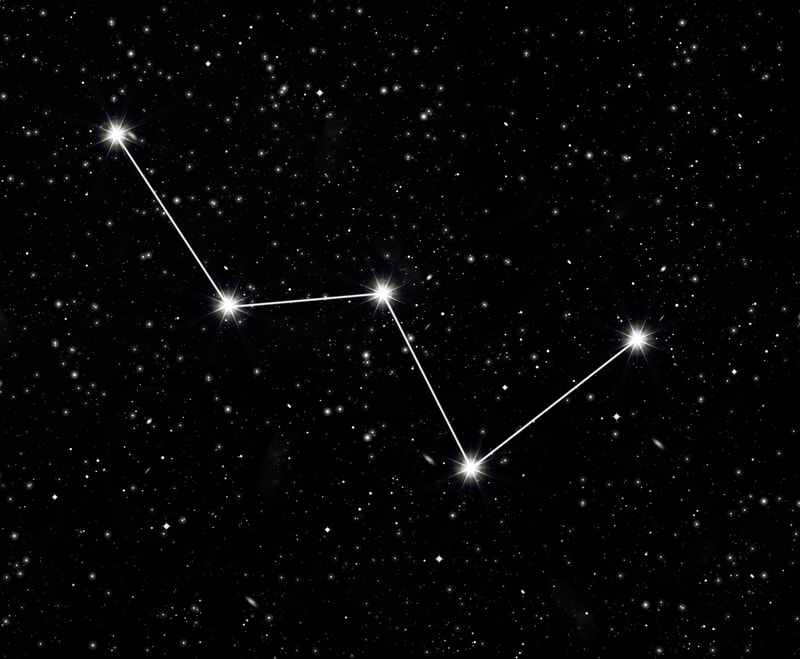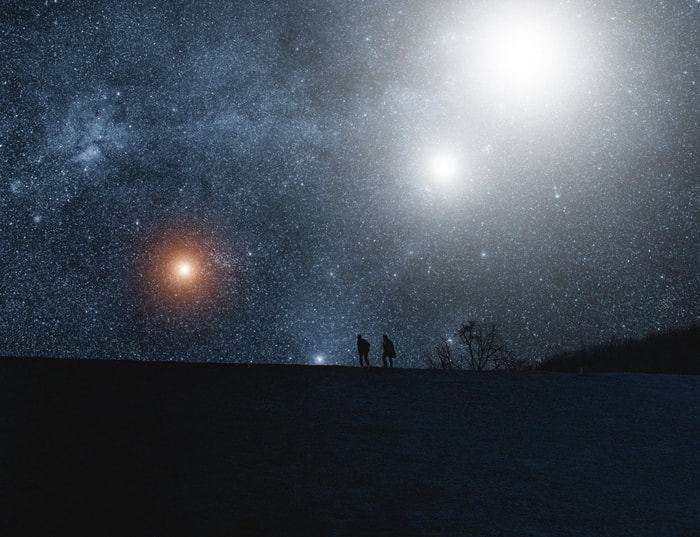Astronomy is the study of celestial objects and processes, and the chemistry, physics and evolution of these objects and processes.
Objects studied include:
Objects studied include:
- Galaxies
- Stars
- Planets
- Moons
- Asteroids
- Nebulae
- Comets
- Ancient Egyptians charted the movement of the sun, the cycles of the moon, and the constellations. They created a calendar system of a 12-parted year, which contained 365 ¼ days. Clocks, made with sun-dials, or with moving water, were used. In addition, the Great Pyramid is almost exactly aligned with true north. They often used astronomy to determine the flooding of the Nile.
Module 2 History
- In Ancient China, one of the main functions of astronomy was to keep time, and to create new calendars for new dynasties. In addition, the astronomical observations were used for astrological divination.
- Ancient India practiced astronomy and astrology, and the earliest references to astronomy in India are found in the Rig Veda, a canonical sacred text of the Hindu religion. The vernal equinox in Orion, and the beginning of the year, were marked in this text.
- In Ancient Babylon, in the civilization of Sumeria, astronomy was widely practiced, inextricably linked to astrology. Their astronomy study was used for agricultural purposes and for assisting royal leaders in making decisions, and they also identified constellations which are still in use today.
- Ancient Greek writer Homer mentioned various celestial objects in his writings, some of the earliest recorded in Greek literature. The Ancient Greeks created a model of the universe to try to account for their observations, which was taught widely up until recent times. Aristotle, Plato and Pythagoras were prominent figures.
- During the dark ages of Europe, astronomy in the Islamic world flourished, with scholars studying and expanding on works from ancient Greece and Rome. It also drew knowledge from Indian astronomy. The Koran makes frequent references to astronomical patterns, and is a major source of Islamic astronomical tradition.
- An astronomical observatory, known as Namoratunga, or ‘the African stonehenge’, was built in Kenya around 300 B.C. It consists of pillars aligned with various star systems.
- The ancient Celts, particularly the druids, practiced astronomy, evidenced by the discovery of the Calendar of Coligny.
- The ancient Romans developed complex calendar systems, which were refined through time. The different days were associated with different planets, and the calendar system was linked to the worship of various gods.
Module 2: The Night Sky
Branches of Astronomy
Though there are many ways astronomy can be divided into branches, here we will focus on six different specializations.
Planetary astronomers – This field is both observational and theoretical. The observational researchers study the planets of the Solar System, to determine their spin, shape, weathering, surface materials and characteristics. They also aim to understand the formation and evolution of these planets. The theoretical researchers concern themselves with dynamics, applying the principles of celestial mechanics to our Solar System.
Solar astronomers – Solar astronomy, closely related to solar physics, is the study of a single star, our Sun. Researchers make detailed measurements, made possible because of the sun’s relatively close proximity.
Branches of Astronomy
Though there are many ways astronomy can be divided into branches, here we will focus on six different specializations.
Planetary astronomers – This field is both observational and theoretical. The observational researchers study the planets of the Solar System, to determine their spin, shape, weathering, surface materials and characteristics. They also aim to understand the formation and evolution of these planets. The theoretical researchers concern themselves with dynamics, applying the principles of celestial mechanics to our Solar System.
Solar astronomers – Solar astronomy, closely related to solar physics, is the study of a single star, our Sun. Researchers make detailed measurements, made possible because of the sun’s relatively close proximity.
Module 3
Stellar astronomers – Stellar astronomy is the study of stars, including nebulae, white dwarfs, black holes and supernovae. The study of stars, and of stellar evolution, is crucial for our understanding of the whole Universe. Both observational and theoretical researchers work in this field. Many computer simulations have been made also. This field studies the process of star formation, which happens in giant molecular clouds, dense regions of gas and dust. Fragments of these clouds are collapsed by gravity, forming a protostar. After nuclear fusion, a main-sequence star is created. It is interesting to note that nearly all the elements that are heavier than helium and hydrogen were created inside the inner cores of stars.
Galactic astronomers – The Milky Way is the spiral galaxy that contains our Solar System. Held together by gravitational attraction, it consists of stars, dust, gas, and other celestial objects that rotate together. The Earth is located in its dusty outer portion. There is a central core to the Milky Way, believed to have a supermassive black hole at its center. Galactic astronomers devote their research to the Milky Way, and discovering the other bodies that it consists of.
Stellar astronomers – Stellar astronomy is the study of stars, including nebulae, white dwarfs, black holes and supernovae. The study of stars, and of stellar evolution, is crucial for our understanding of the whole Universe. Both observational and theoretical researchers work in this field. Many computer simulations have been made also. This field studies the process of star formation, which happens in giant molecular clouds, dense regions of gas and dust. Fragments of these clouds are collapsed by gravity, forming a protostar. After nuclear fusion, a main-sequence star is created. It is interesting to note that nearly all the elements that are heavier than helium and hydrogen were created inside the inner cores of stars.
Galactic astronomers – The Milky Way is the spiral galaxy that contains our Solar System. Held together by gravitational attraction, it consists of stars, dust, gas, and other celestial objects that rotate together. The Earth is located in its dusty outer portion. There is a central core to the Milky Way, believed to have a supermassive black hole at its center. Galactic astronomers devote their research to the Milky Way, and discovering the other bodies that it consists of.
Extragalactic astronomers – This branch of astronomy is concerned with the observation of active galaxies, and of groups and clusters of galaxies. Researchers in this field study how galaxies are formed, how they evolve, and how they die out, and decide how they should be classified (spiral, elliptical and irregular). They use all this information to get a better understanding of the structure of the cosmos on a large scale.
Cosmologists – Cosmologists focus on the whole universe. They study the past, present and the future, all the way from the widely accepted theory of the big bang 13.8 billion years ago, to its present evolution, and to its eventual death. It is focused on large scale properties and theoretical phenomena like dark matter, dark energy, multiple universes and string theory.
Cosmologists – Cosmologists focus on the whole universe. They study the past, present and the future, all the way from the widely accepted theory of the big bang 13.8 billion years ago, to its present evolution, and to its eventual death. It is focused on large scale properties and theoretical phenomena like dark matter, dark energy, multiple universes and string theory.
Module4
The phases of the moon, or lunar phases, describe the shape of the portion of the moon that is lit up or illuminated by the sun, as seen from Earth. As the moon orbits the Earth, and the positions of the sun and the moon relative to Earth change, the lunar phase changes. The pattern of lunar phases is regular, and runs in cycles of approximately 29 days.
In the Western culture, there are four main lunar phases. When 0% of the moon is seen as illuminated from the Earth, this is called new moon. When the moon is 50% lit, on the right side, this is known as the first quarter. When 100% is seen as illuminated, this is called full moon. When it appears that 50% of the moon is lit, this time on the left side, this is known as the third quarter or the last quarter. When a moon is in the stage between new moon and full moon, i.e. getting fuller, it is waxing. When it is in the stage between full moon and new moon, i.e. the illuminated portion is getting smaller, this is known as waning.
The phases of the moon, or lunar phases, describe the shape of the portion of the moon that is lit up or illuminated by the sun, as seen from Earth. As the moon orbits the Earth, and the positions of the sun and the moon relative to Earth change, the lunar phase changes. The pattern of lunar phases is regular, and runs in cycles of approximately 29 days.
In the Western culture, there are four main lunar phases. When 0% of the moon is seen as illuminated from the Earth, this is called new moon. When the moon is 50% lit, on the right side, this is known as the first quarter. When 100% is seen as illuminated, this is called full moon. When it appears that 50% of the moon is lit, this time on the left side, this is known as the third quarter or the last quarter. When a moon is in the stage between new moon and full moon, i.e. getting fuller, it is waxing. When it is in the stage between full moon and new moon, i.e. the illuminated portion is getting smaller, this is known as waning.
Module 5
Solar eclipses
There is an average of 2.4 solar eclipses every year, and there are four types of solar eclipse.
Partial eclipse – A partial solar eclipse happens when the moon covers part of the Sun. This gives the appearance that a ‘bite’ has been taken out of the Sun. During this type of eclipse, the Moon’s umbral shadow (darker, smaller) misses the Earth, but the penumbral shadow (larger, longer-ranging, lighter) falls on the surface of the Earth. The umbral shadow passes over either the north or south pole of the Earth.
Those in the parts of Earth where the penumbral shadow of the Moon has fallen will be able to experience the eclipse, and the pattern of the eclipse will change with the movement of the moon.
Annular eclipse – An annular eclipse happens when the center of the Sun gets covered by the moon, but the edges remain uncovered. This gives the effect of a ring of light, where the edges of the Sun remain uncovered. In this case, the moon appears smaller than the Sun. When the Moon casts its dark umbral shadow on the Earth, those in this umbral area will be able to see the annual eclipse.
Solar eclipses
There is an average of 2.4 solar eclipses every year, and there are four types of solar eclipse.
Partial eclipse – A partial solar eclipse happens when the moon covers part of the Sun. This gives the appearance that a ‘bite’ has been taken out of the Sun. During this type of eclipse, the Moon’s umbral shadow (darker, smaller) misses the Earth, but the penumbral shadow (larger, longer-ranging, lighter) falls on the surface of the Earth. The umbral shadow passes over either the north or south pole of the Earth.
Those in the parts of Earth where the penumbral shadow of the Moon has fallen will be able to experience the eclipse, and the pattern of the eclipse will change with the movement of the moon.
Annular eclipse – An annular eclipse happens when the center of the Sun gets covered by the moon, but the edges remain uncovered. This gives the effect of a ring of light, where the edges of the Sun remain uncovered. In this case, the moon appears smaller than the Sun. When the Moon casts its dark umbral shadow on the Earth, those in this umbral area will be able to see the annual eclipse.
Total Eclipse – A total eclipse happens when the sun appears completely covered by the moon. During a total eclipse, the moon is close enough to the Earth to almost completely block off the light of the sun with its umbral shadow. The darkest point of a total eclipse can be as dark as night, with only the Sun’s corona, a faint ring of rays, visible around the dark moon. During this time, the sky will go dark, animals and birds begin to quieten, and temperatures can fall drastically.
A total eclipse begins and ends with a partial eclipse, as the moon appears to make its way across the Sun. About 10 seconds before and after the total eclipse, observers may notice Baily’s beads or the diamond ring effect. Baily’s beads are blobs of light, shaped like beads, that appear at the edge of the moon. The diamond ring effect is when the corona begins to appear, and a large Baily’s bead still shines through. This gives the appearance of a diamond ring.
Hybrid Eclipse – This is quite a rare event. This happens when an eclipse is seen as a total eclipse by people in one part of the Earth, and as an annular eclipse by people in another.
This happens because the curve of the Earth’s surface increases the apparent size of the moon from some angles on Earth, but not on others. This means that for the majority of people, an annual eclipse will be visible, but those at a specific angle to the moon will see a total eclipse.
Module 6
Basics of the Celestial Sphere
Basics of the Celestial Sphere
The celestial sphere is an imaginary sphere in the sky, with the earth located at its center. It could almost be imagined as a large dome in the sky, whereupon all the objects able to be observed in the sky are projected. The sphere would extend around the whole Earth, but because of where we stand, we would only be able to see half of it. The other half would be obscured from view by the Earth itself.
This idea of a celestial sphere is very useful for giving positions of objects in sky, like coordinates are used to plot things on Earth. Just as, on Earth, we have the north pole, south pole and the equator, these are extended into the celestial sphere as the celestial north pole, the celestial south pole, and the celestial equator.
On Earth, we use latitude and longitude to plot a location, in the sky we use declination and right ascension, respectively. Declination is similar to latitude, with positive declination in the north and negative declination in the south. Right ascension is the equivalent of longitude, and it is measured in hours, one hour being equal to 15 degrees.
Astronomers use the celestial sphere and its coordinates regularly, and is thought of as a sort of astronomical shorthand. It is often used to talk about objects when astronomers are not sure how far they are away from the Earth.
This idea of a celestial sphere is very useful for giving positions of objects in sky, like coordinates are used to plot things on Earth. Just as, on Earth, we have the north pole, south pole and the equator, these are extended into the celestial sphere as the celestial north pole, the celestial south pole, and the celestial equator.
On Earth, we use latitude and longitude to plot a location, in the sky we use declination and right ascension, respectively. Declination is similar to latitude, with positive declination in the north and negative declination in the south. Right ascension is the equivalent of longitude, and it is measured in hours, one hour being equal to 15 degrees.
Astronomers use the celestial sphere and its coordinates regularly, and is thought of as a sort of astronomical shorthand. It is often used to talk about objects when astronomers are not sure how far they are away from the Earth.
Module 7
Beginning your own journey into astronomy can be a tremendously exciting experience, but it also comes with uncertainty. In the next three sections, we’ll help you with all the information you need to know to begin learning about our universe and how you can observe some of it.
The possibilities
Astronomy and stargazing can be extremely rewarding. Not only does it give you a sense of where you are in the Universe, it can also impress upon you a sense of awe and wonder about how small we are in this massive space.
Many amateurs are amazed to find out that you can see a galaxy over two million light years away, just with unaided eyes. You can also see craters on the Moon when you use binoculars, and a whole host of exciting phenomena with a telescope.
Some amateur astronomers even contribute to the field with new discoveries.
Beginning your own journey into astronomy can be a tremendously exciting experience, but it also comes with uncertainty. In the next three sections, we’ll help you with all the information you need to know to begin learning about our universe and how you can observe some of it.
The possibilities
Astronomy and stargazing can be extremely rewarding. Not only does it give you a sense of where you are in the Universe, it can also impress upon you a sense of awe and wonder about how small we are in this massive space.
Many amateurs are amazed to find out that you can see a galaxy over two million light years away, just with unaided eyes. You can also see craters on the Moon when you use binoculars, and a whole host of exciting phenomena with a telescope.
Some amateur astronomers even contribute to the field with new discoveries.
Module 8
With the naked eye
Learning to read the night sky should always begin with the unaided eye, experts advise. There is plenty to be learned before you even need equipment such as binoculars or telescopes.
You can find naked eye star charts in astronomy magazines, or order them online. You can also get yourself a planisphere, from which you can learn the constellations visible throughout the year. Go outside at night and familiarize yourself with the constellations, with these guides as a reference.
With binoculars
Once you have become familiar with the constellations and what can be seen with the naked eye, you will want to move onto using binoculars. Using these, you can look at the craters, plains and mountains of the Moon, among other things.
Using information from the maps and guidebooks you’ll have sourced, you can use binoculars to see nebulae, galaxies and star clusters. You’ll also be able to observe the crescent phases of planet Venus, plus the changing positions of the moons of Jupiter. You might also choose to follow double stars, and watch the fading and brightening of numerous other stars.
It is advised that before you go outside with your binoculars, you plan what you want to look for. Spread out your maps and charts, identify objects that will be visible with the binoculars, and plan carefully. Then, once you know what you’re doing, head outside with your equipment and see what you can find.
Astronomy diary
Though this is optional, many experts advise keeping a diary and making brief notes.
It is easy to purchase a notebook and keep it with the rest of your astronomy books and equipment.
Writing down a log of your activities with dates will help you to look back and see how far you have progressed.
With the naked eye
Learning to read the night sky should always begin with the unaided eye, experts advise. There is plenty to be learned before you even need equipment such as binoculars or telescopes.
You can find naked eye star charts in astronomy magazines, or order them online. You can also get yourself a planisphere, from which you can learn the constellations visible throughout the year. Go outside at night and familiarize yourself with the constellations, with these guides as a reference.
With binoculars
Once you have become familiar with the constellations and what can be seen with the naked eye, you will want to move onto using binoculars. Using these, you can look at the craters, plains and mountains of the Moon, among other things.
Using information from the maps and guidebooks you’ll have sourced, you can use binoculars to see nebulae, galaxies and star clusters. You’ll also be able to observe the crescent phases of planet Venus, plus the changing positions of the moons of Jupiter. You might also choose to follow double stars, and watch the fading and brightening of numerous other stars.
It is advised that before you go outside with your binoculars, you plan what you want to look for. Spread out your maps and charts, identify objects that will be visible with the binoculars, and plan carefully. Then, once you know what you’re doing, head outside with your equipment and see what you can find.
Astronomy diary
Though this is optional, many experts advise keeping a diary and making brief notes.
It is easy to purchase a notebook and keep it with the rest of your astronomy books and equipment.
Writing down a log of your activities with dates will help you to look back and see how far you have progressed.










